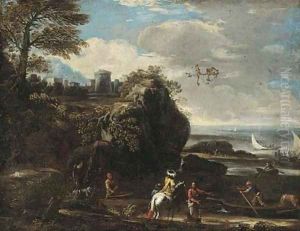Adriaan Van Der Cabel Paintings
Adriaan van der Cabel, also known as Adriaen van der Cabel, Adriaen van der Kabel, Arie van der Cabel, or Ary van der Cabel, was a Dutch Golden Age landscape painter who was born in Rijswijk near The Hague in 1631. His early life and training are not well-documented, but it is believed that he was a pupil of Jan van Goyen, a prominent landscape painter of the time, which would explain the strong influence of van Goyen's style in van der Cabel's work.
Van der Cabel's career took a significant turn when he moved to Lyon, France, in the 1650s. This move was likely motivated by the opportunities presented by the growing art market in France, as well as by the political turmoil in the Netherlands during this period. In Lyon, he became known for his Italianate landscapes, which were influenced by the work of Claude Lorrain and were characterized by their picturesque and idealized depiction of nature. His works often included classical ruins, pastoral figures, and a warm, golden light, which appealed to French collectors.
Around 1663, van der Cabel moved to Paris, where he continued to work and sell his paintings. His work was well received, and he became part of the thriving community of Dutch artists who had settled in France. Despite his success, little is known about his activities in Paris, and in 1665, he returned to Lyon, where he remained for the rest of his life.
Adriaan van der Cabel's paintings were popular with collectors in France and abroad, and his landscapes had a significant influence on the development of French landscape painting. His style evolved over time, showing an increased interest in dramatic lighting and a more rugged portrayal of nature. Despite his Dutch origins, his work represents a successful fusion of Dutch landscape conventions with French and Italian influences, making him an important figure in the European art world of his time.
Van der Cabel died in Lyon in 1705. His works can be found in various museums and collections across Europe, and they continue to be studied for their contribution to the landscape genre. Although not as well-known as some of his contemporaries, Adriaan van der Cabel's artistic legacy remains significant, particularly in the context of the cross-cultural exchange of artistic ideas in the 17th century.
